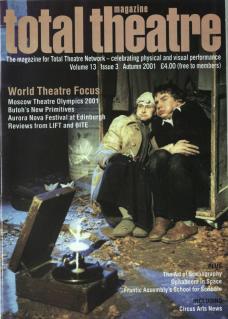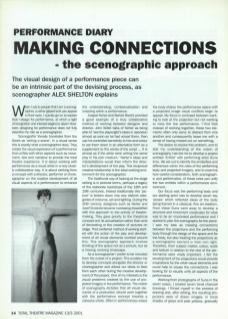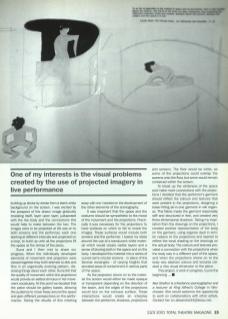When I say to people that I am a scenographer, a rather gazed look can appear in their eyes. I quickly go on to explain that I design for performance, at which a light of recognition and interest begins to dawn! However, designing for performance does not fully describe my role as a scenographer.
'Scenografia' literally translates from the Greek as 'writing a scene'. In a visual sense this is exactly what a scenographer does. They create the visual expression of a performance that unifies with other aspects such as movement, text and narrative to provide the total theatre experience. It is about working with performance as a visual artist in a very closely collaborative way. It is about working from a concept with a director, performer or choreographer on the creative development of all visual aspects of a performance to enhance the understanding, contextualisation and meaning within a performance.
Caspar Neher and Bertolt Brecht provided a good example of a truly collaborative method of working between designer and director. John Willet talks of Neher as being able to ‘see the playwright's ideas in operation almost as soon as he had voiced them, then use his controlled sensitivity to line and colour to set them down in an alternative form as a supplement to the words of the script... It is almost as if the artist were writing the same play in his own medium.' Neher's ideas and interpretations would then inform the director's development of the play. This reciprocal creative relationship is the ideal working environment for the scenographer.
The traditional way of looking at the stage setting is in pictorial terms, perhaps a legacy of the elaborate backdrops of the 18th and 19th centuries. Indeed traditionally this ‘picture' is broken down into very distinct categories of costume, set and lighting. During the 20th century, designers such as Neher and Josef Svoboda became increasing dissatisfied with this approach to the activity of theatre-making. They gave priority to the theatrical concept and its actualisation rather than acts of decorating or the creation of pictures on stage. Their preferred method of working started with the action of the play and development of all visual elements centred around this. This scenographic approach involves thinking of the space not as a picture, but as a moving, evolving timescape.
As a scenographer I prefer to be included from the outset of a project. This enables me to develop concepts alongside the director or choreographer and allows our ideas to feed from each other during the creative development of the project. One of my interests is the visual problems created by the use of projected imagery in live performance. The notion of scenography dictates that all visual elements of a production should work together with the performance concept towards a cohesive whole. Often in performances where the body shares the performance space with a projected image visual conflicts begin to appear. My focus is confused between wanting to look at the projection but not wanting to miss the live performance. I find that instead of working together, these two elements often only serve to distract from one another and consequently leave me with a sense of having missed out on something.
The desire to resolve this problem, and to test my understanding of the notion of scenography, has led me to develop a project entitled Enfold with performing artist Suna Imre. We set out to identify the similarities and differences within the roles of the performing body and projected imagery, and to examine how careful consideration, both scenographic and performative, of these roles can unify the two entities within a performance environment.
Our focus was the performing body and our starting point was to develop seven key ‘poses' which reflected ideas of the body being framed in a classical, fine art tradition. From these Suna went away to develop a structure and movement vocabulary for what was to be an improvised performance and I started to plan the scenography for the piece. I saw my task as creating connections between the projections and the performing body through the design of the space and for the body, but also treating the projections as a scenographic element in their own right. Therefore, their subject matter, colour, scale and texture in relation to the rest of the performance were vitally important. I felt the development of the projections would provide inspirations for the other visual elements and could help to create the connections I was looking for to visually unify all aspects of the performance.
Working from photographs of Suna in the seven poses, I created seven tonal charcoal drawings. I filmed myself in the process of drawing and, after editing, the resulting projections were of drawn images, in tonal shades of greys and pale yellows, gradually building up stroke by stroke from a blank white background on the screen. I was excited by the prospect of the drawn image gradually revealing itself, layer upon layer, juxtaposed with the live body and the connections this would help to make between the two. The images were to be projected at life size on to both screens and the performer, each one starting at different intervals and projected on a loop, to build up until all the projections fill the space at the climax of the piece.
Suna and I then met to share our progress. When the individually developed elements of movement and projection were viewed together they both seemed to ebb and flow in an organically evolving pattern, disclosing things about each other. Suna felt that the quality of movement within the projections would provide an added stimulus in her movement vocabulary. At this point we decided that the piece should be gallery based, allowing the audience to move freely around the space and gain different perspectives on the performance. Taking the results of this meeting away with me I started on the development of the other elements of the scenography.
It was important that the space and the costume should be sympathetic to the mood of the movement and the projections. Practically it was necessary for the projections to have surfaces on which to fall to reveal the images. These surfaces would include both screens and the performer. I based my ideas around the use of a translucent white material which would create visible layers and a sense of blurring both in the space and on the body. I developed this material into a series of curved semi-circular screens – in place of the familiar rectangles – of varying heights that provided areas of containment in various parts of the space.
As the projection shone on to the material the screen would either be made opaque or transparent depending on the direction of the beam, and the edges of the projections would blur on the concave surface. These interactions would create an interplay between the performer, shadows, projections and screens. The floor would be white, so some of the projections could overlap the screens onto the floor, but some would remain contained within the screen.
To break up the whiteness of the space and make more connections with the projections I decided that the performer's garment should reflect the colours and textures that were present in the projections, designing a loose-fitting all-in-one garment in silk organza. This fabric made the garment reasonably stiff and structured in feel, and created very three-dimensional shadows. Taking my inspiration from the drawings on the projections, I created another representation of the body on the garment, using organza dyed in similar colours to the projections and layered to reflect the tonal shading on the drawings on the actual body. The colours and textures provided a connection with the projections when the body was in a different part of the space, and when the projections shone on to the body very abstract colours and textures created a new visual dimension to the piece.
This project, a work-in-progress, is just the beginning...
Alex Shelton is a freelance sceneographer and a lecturer at King Alfred's College in Winchester. She would welcome the opportunity to work on collaborations with other artists. Contact her on alexandra34@tesco.net


